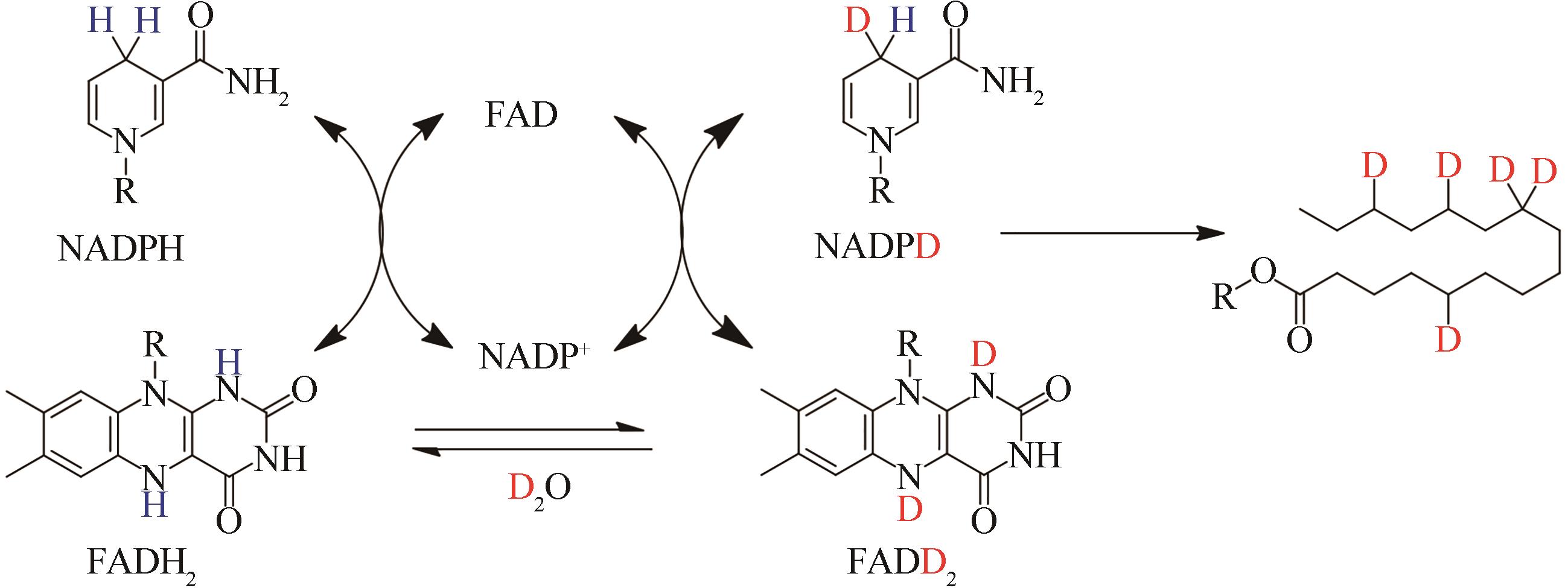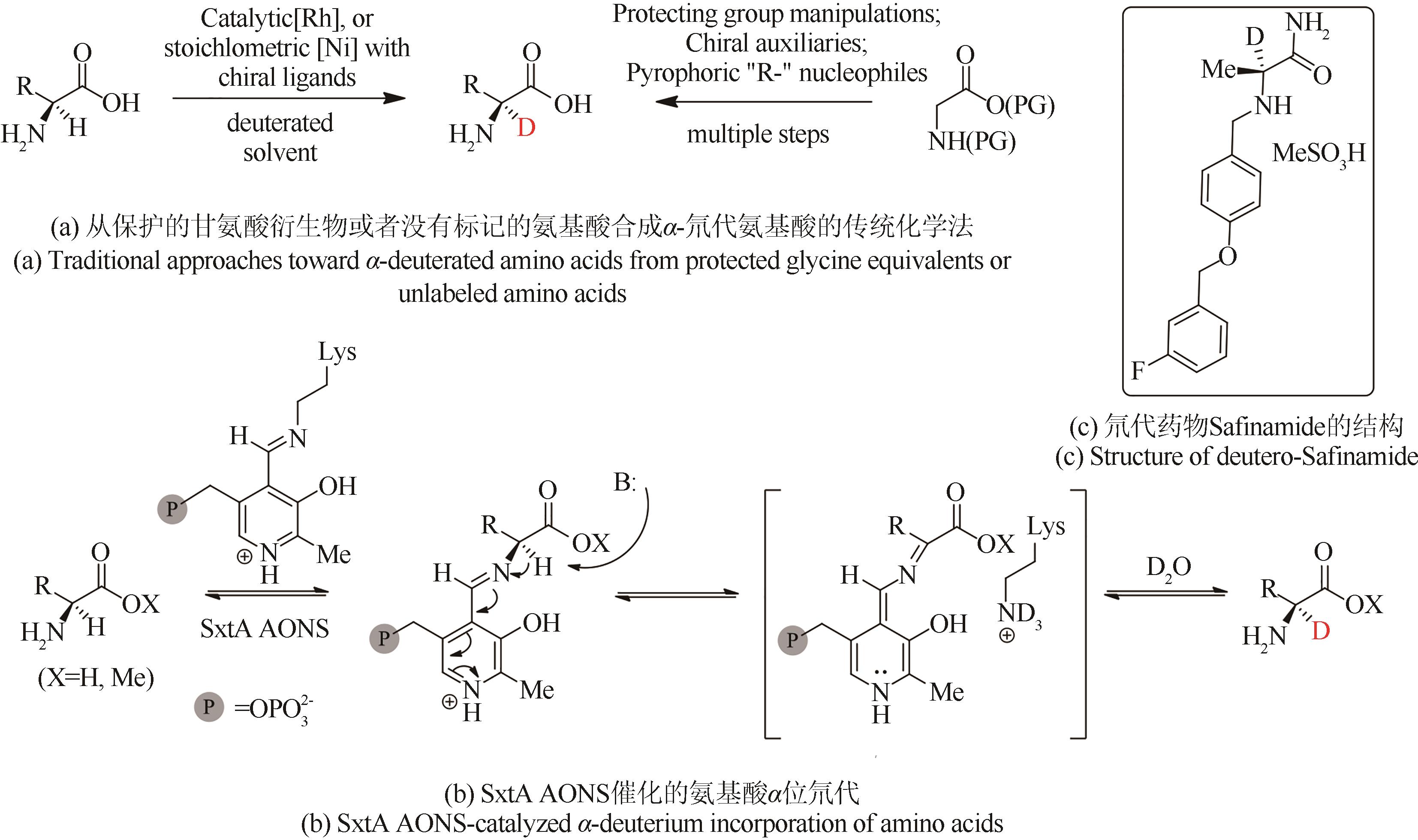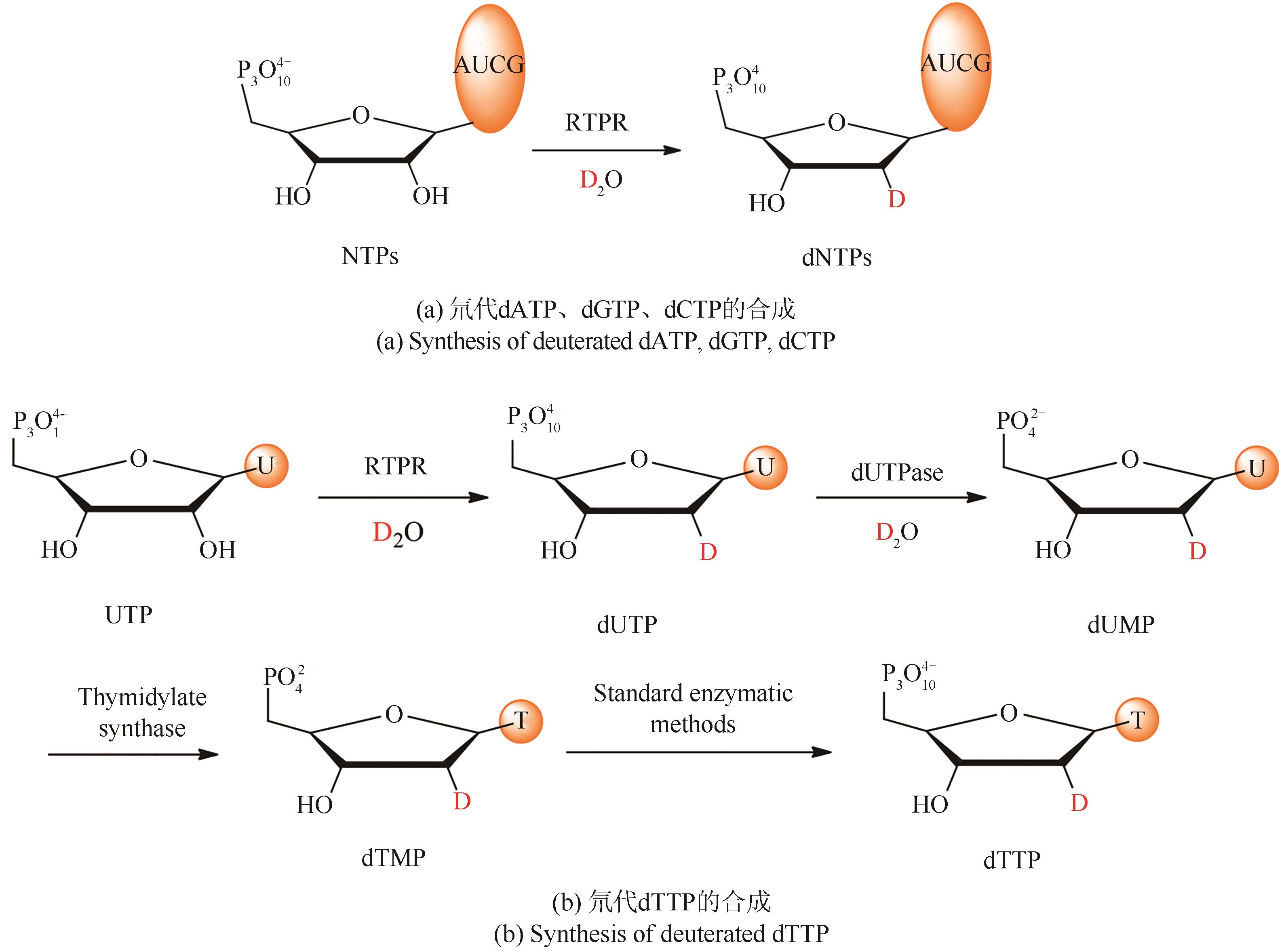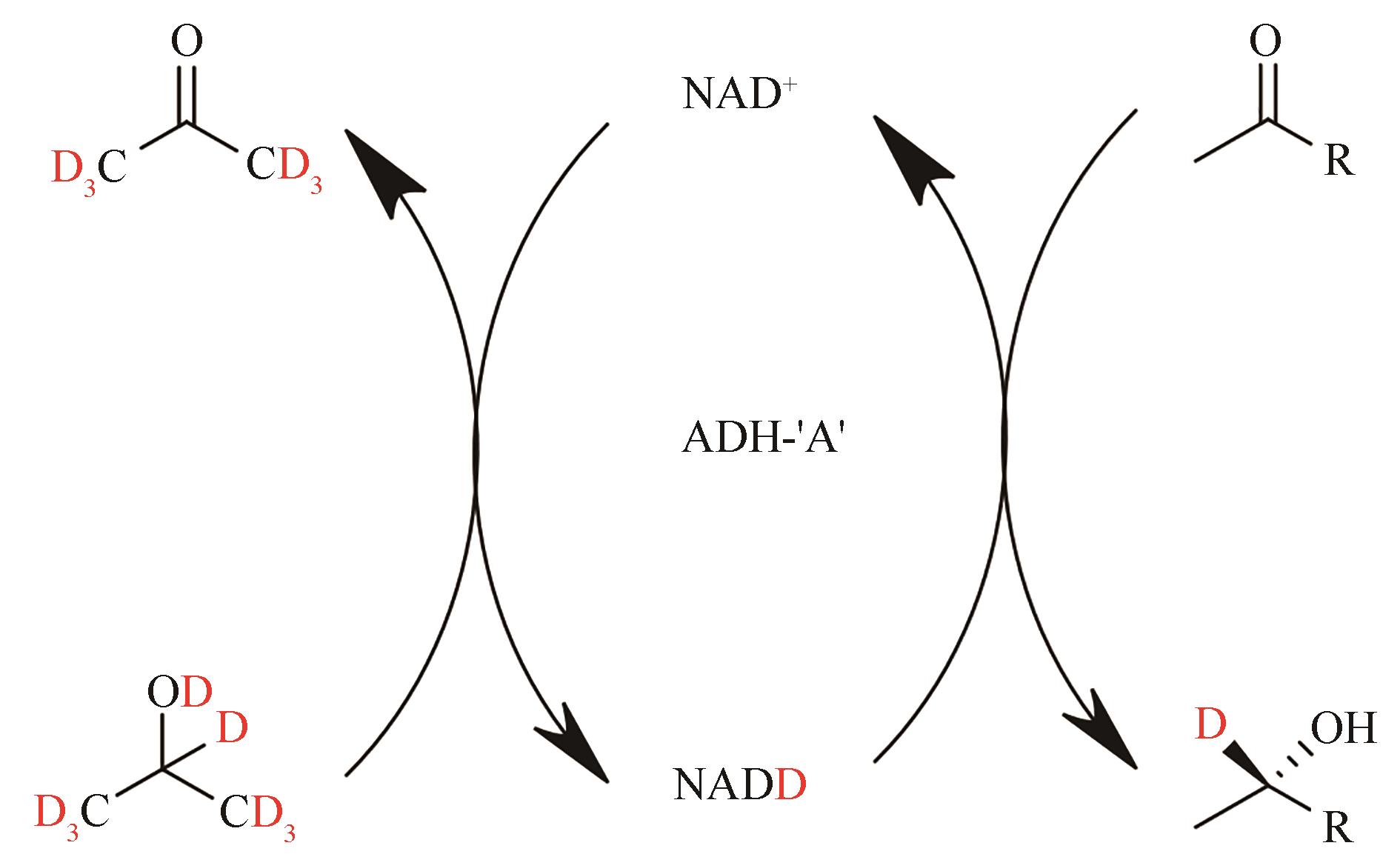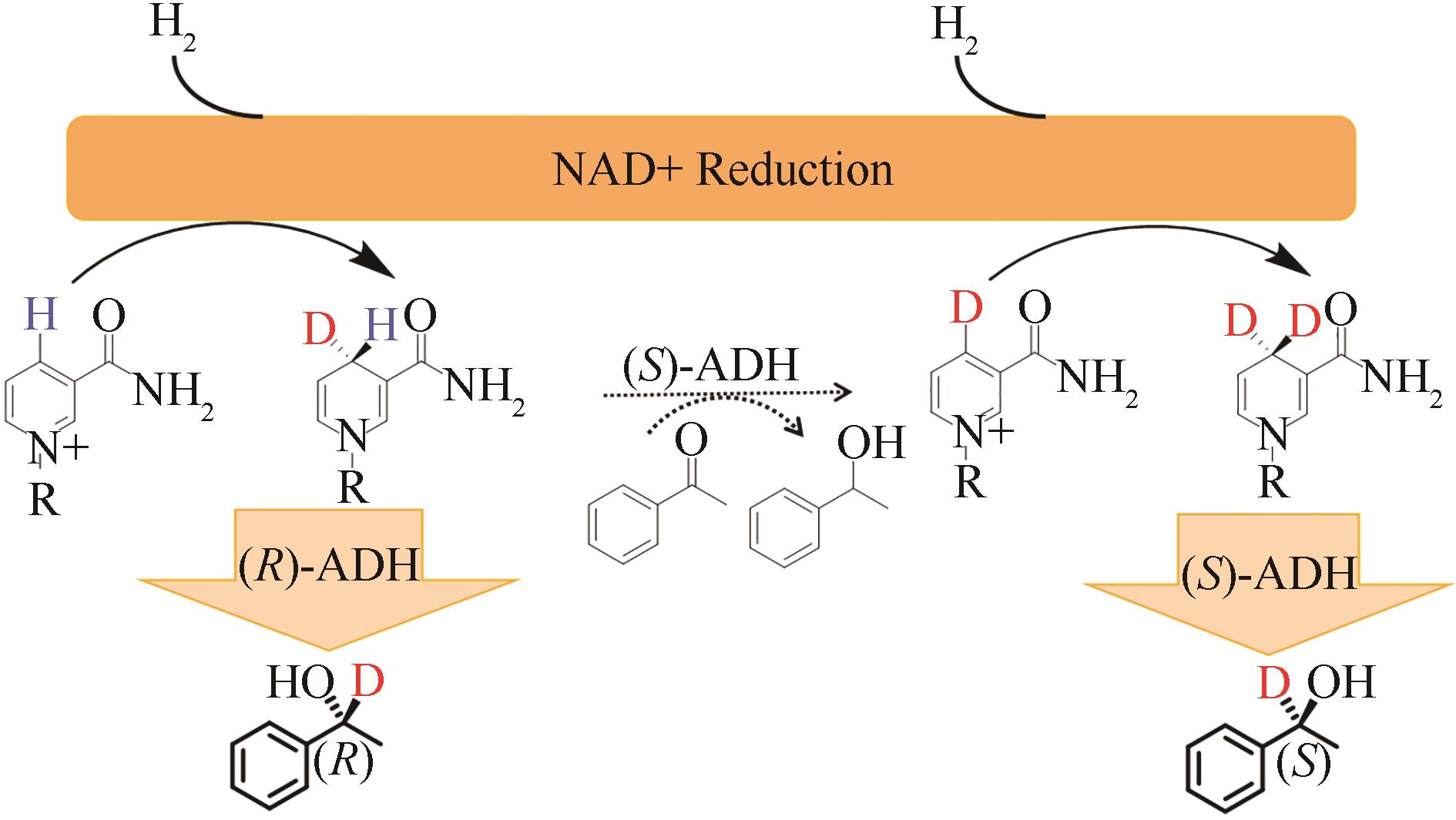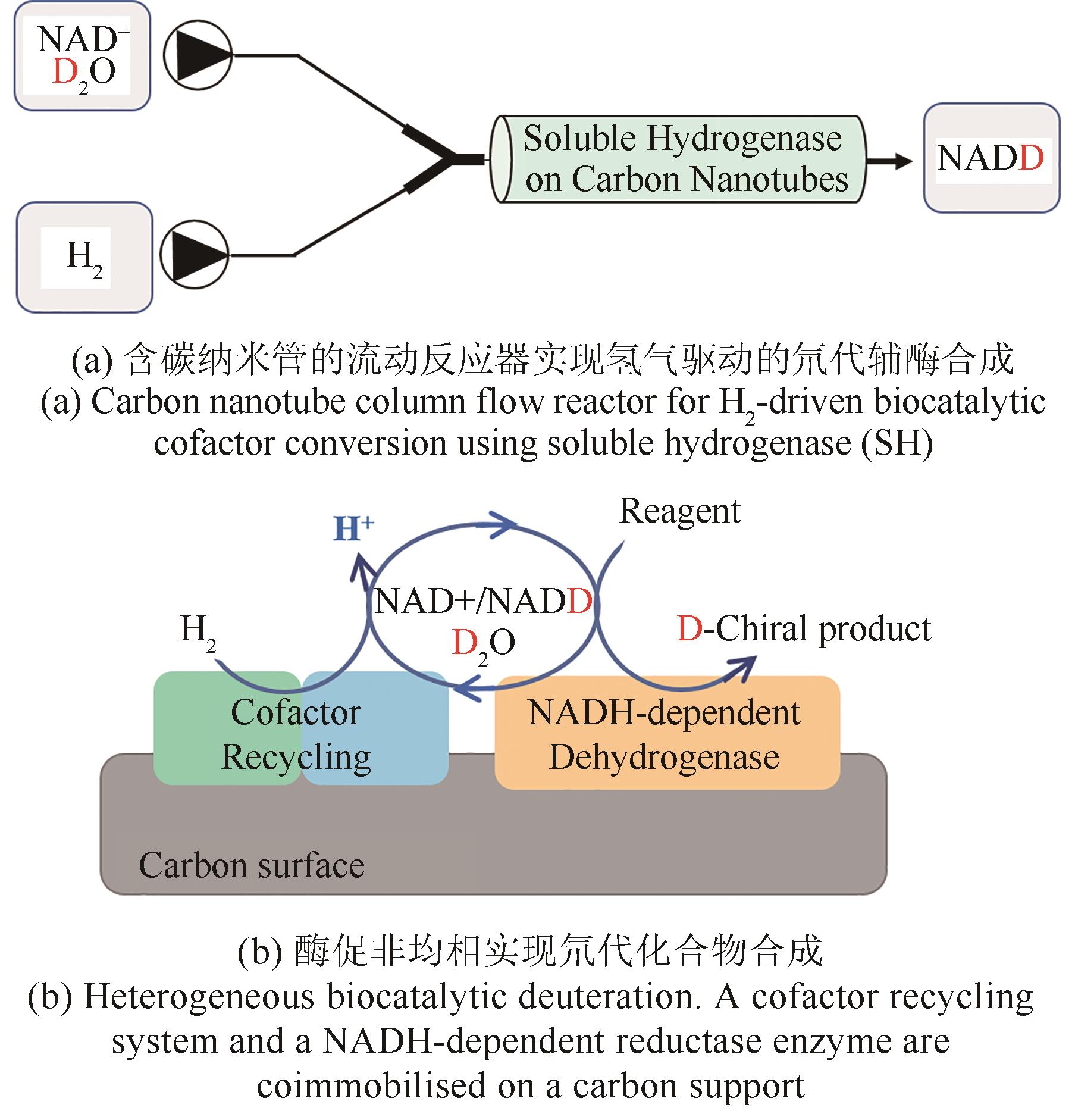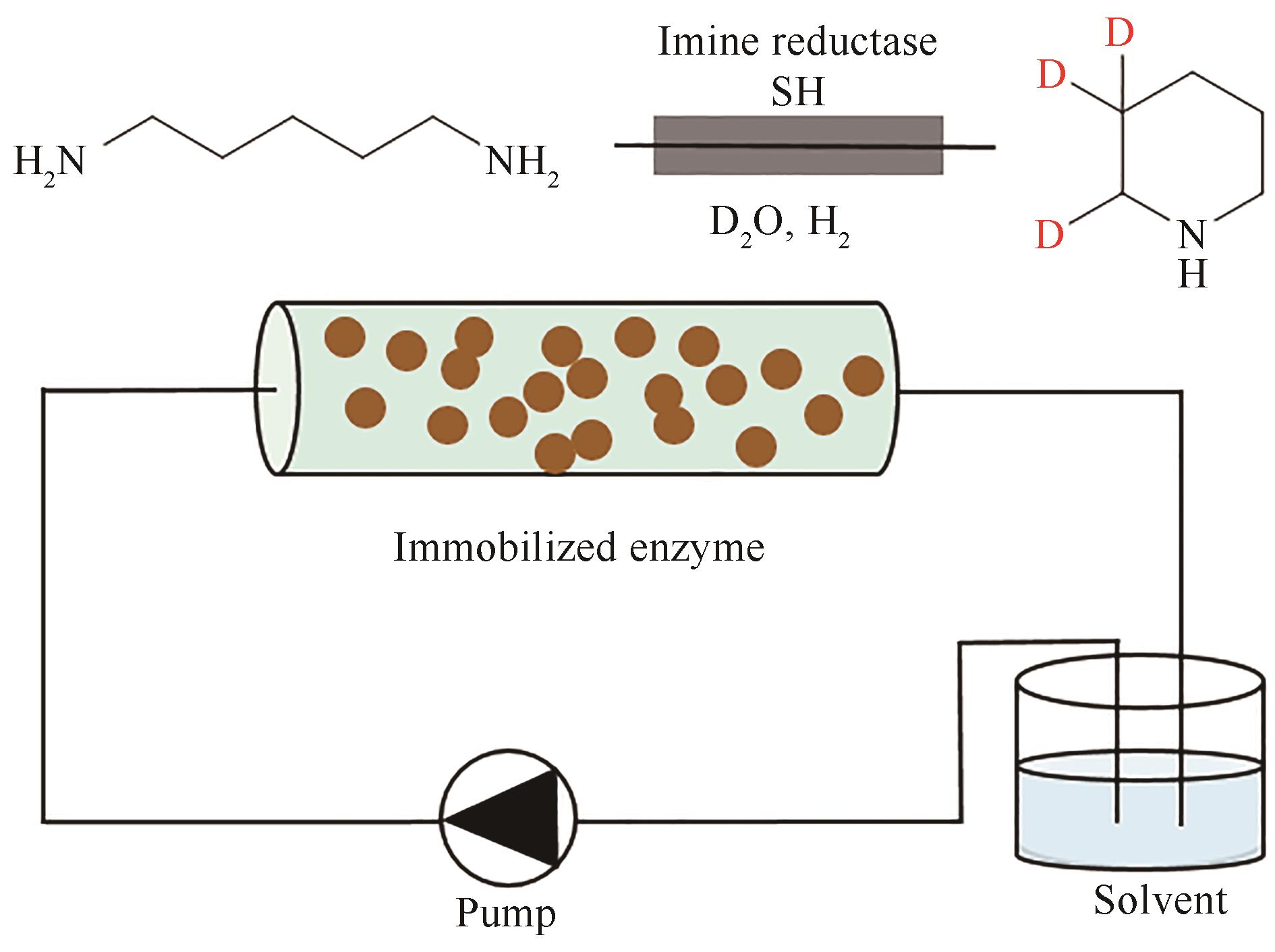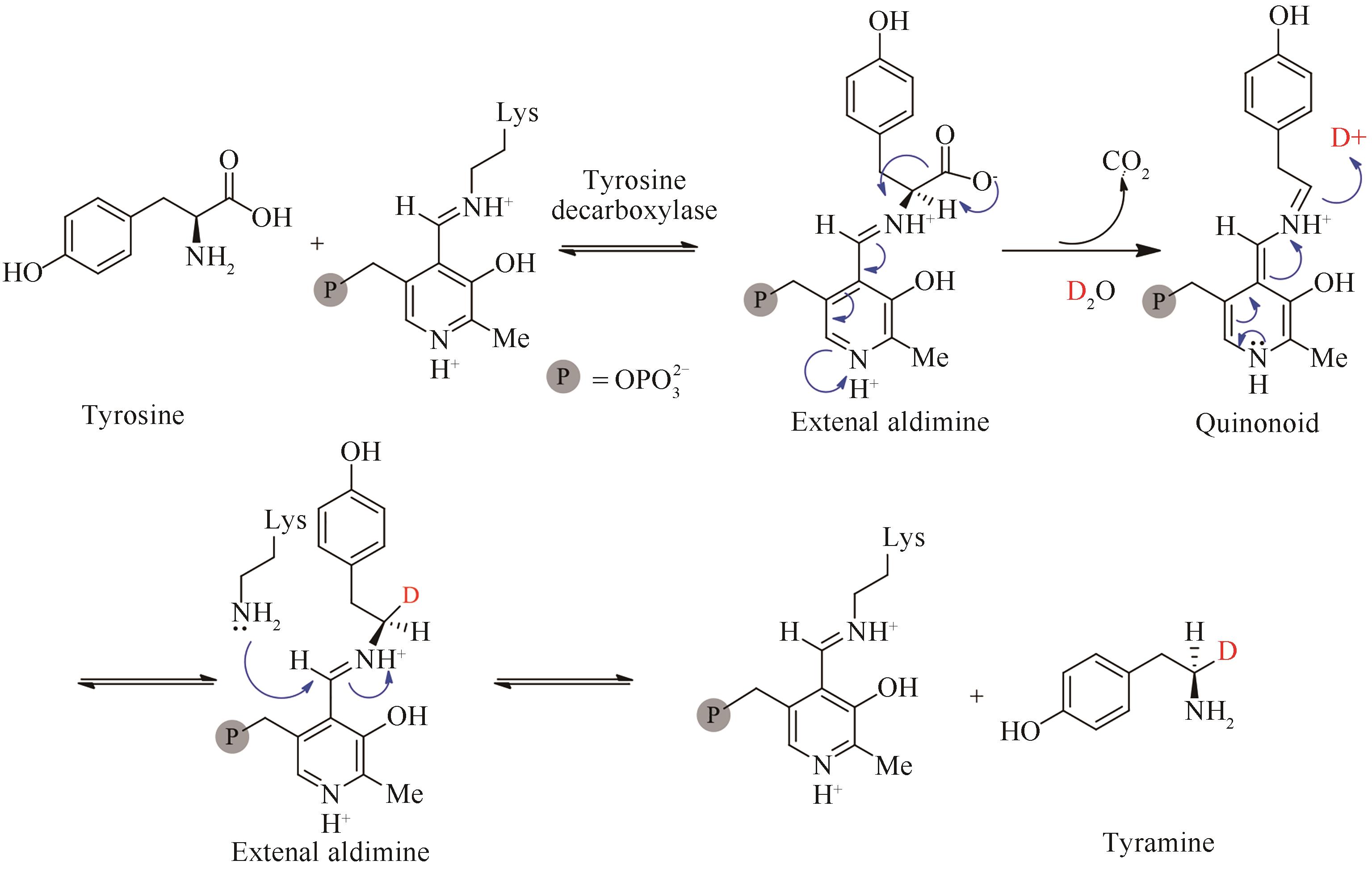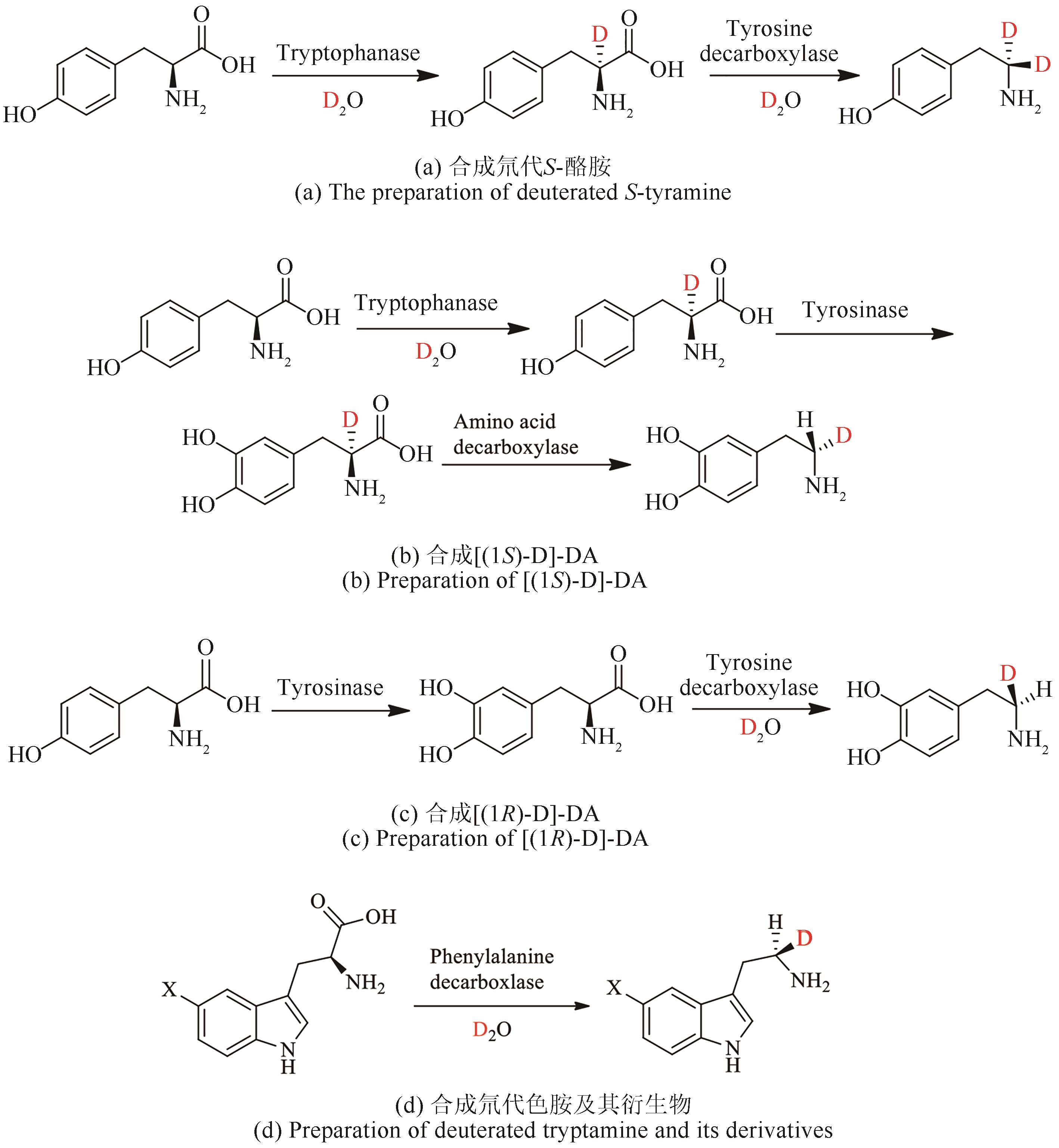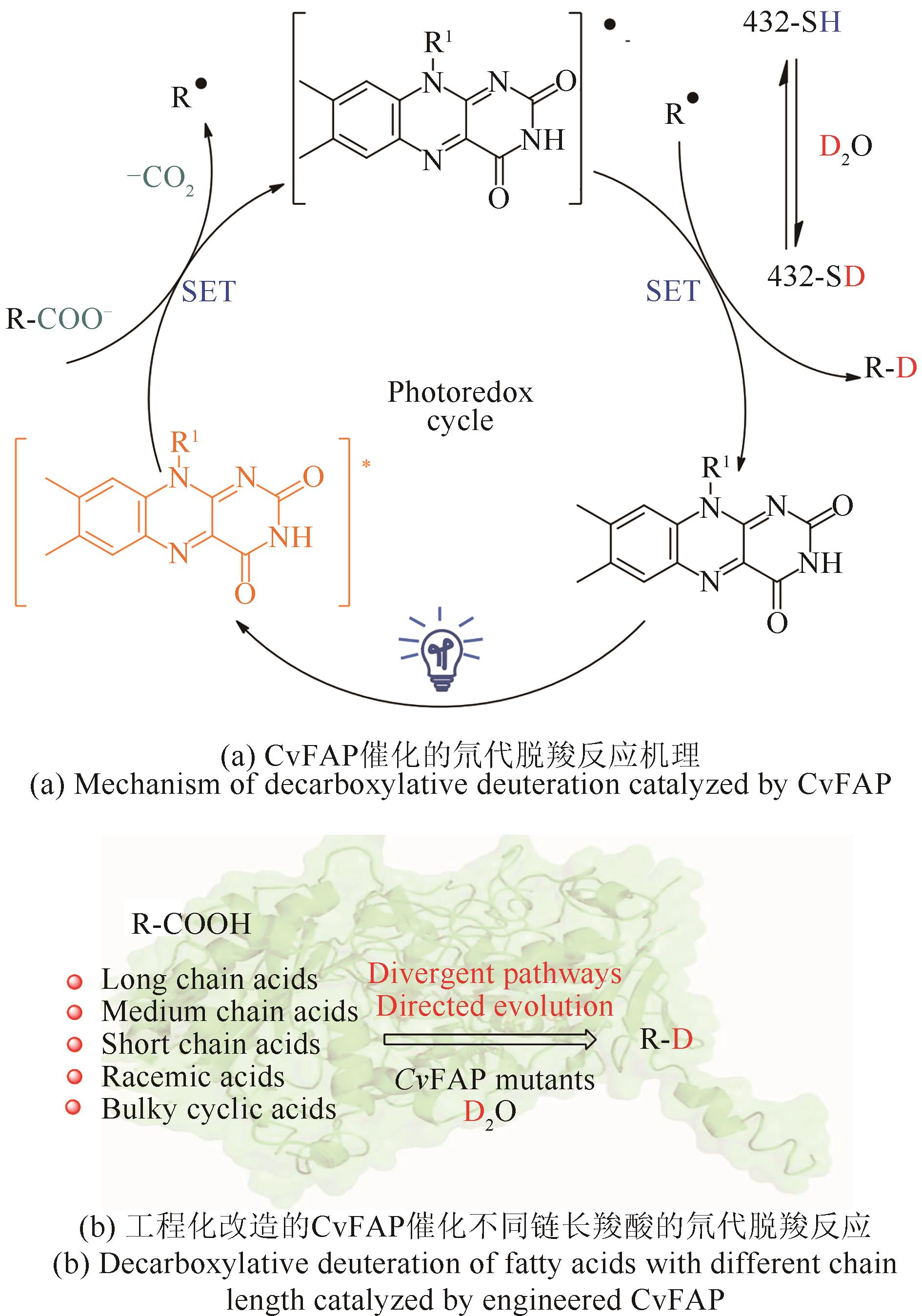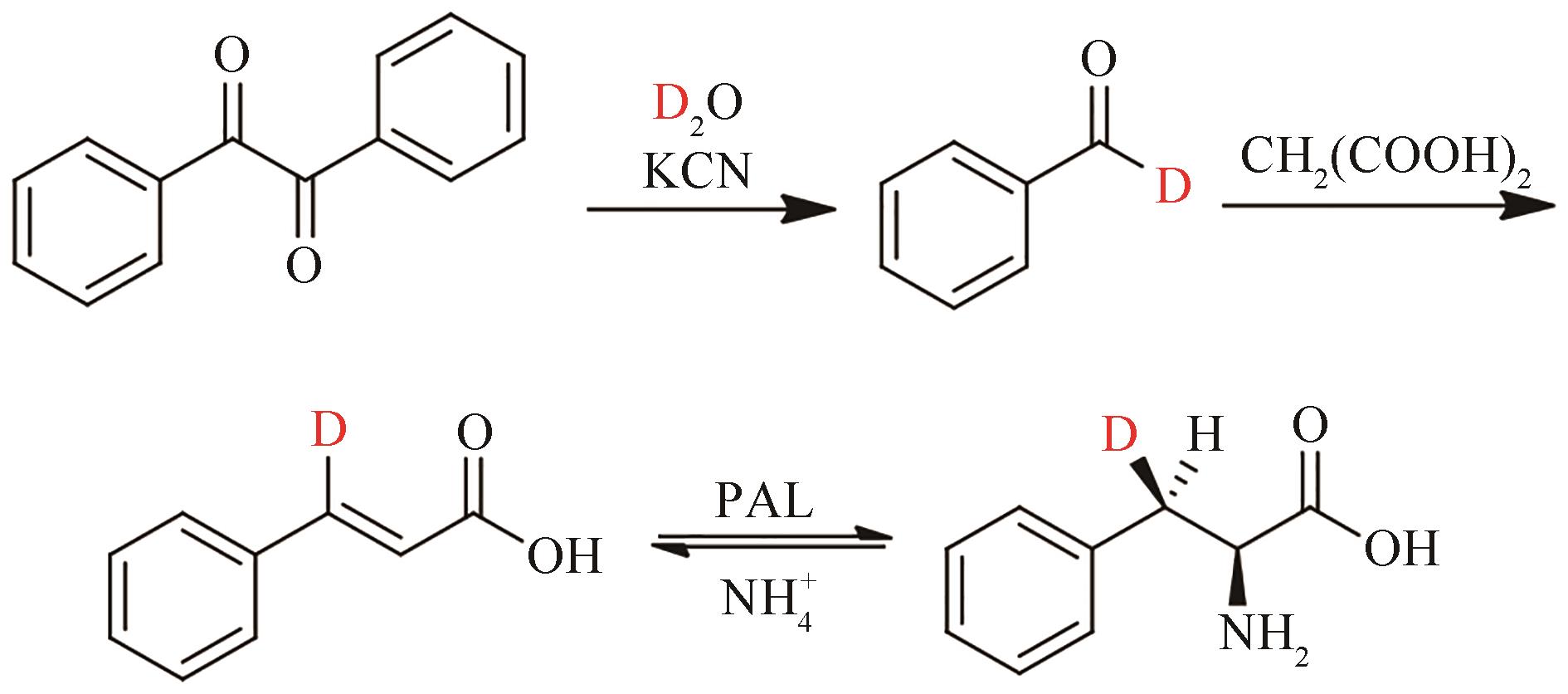Synthetic Biology Journal ›› 2022, Vol. 3 ›› Issue (3): 530-544.DOI: 10.12211/2096-8280.2021-067
• Invited Review • Previous Articles Next Articles
Progress of biocatalytic deuteration of inert carbon-hydrogen bonds
LOU Yujiao1, XU Jian2, WU Qi1
- 1.Department of Chemistry,Zhejiang University,Hangzhou 310027,Zhejiang,China
2.College of Biotechnology and Bioengineering,Zhejiang University of Technology,Hangzhou 310014,Zhejiang,China
-
Received:2021-06-18Revised:2021-11-10Online:2022-07-13Published:2022-06-30 -
Contact:XU Jian, WU Qi
生物催化惰性碳氢键的氘代反应研究进展
楼玉姣1, 徐鉴2, 吴起1
- 1.浙江大学化学系,浙江 杭州 310027
2.浙江工业大学生物工程学院,浙江 杭州 310014
-
通讯作者:徐鉴,吴起 -
作者简介:楼玉姣 (1995—),女,硕士研究生。研究方向为酶定向进化与催化新功能。E-mail: 2560753069@qq.com徐鉴 (1989—),男,教授。研究方向为酶定向进化,合成生物学,酶催化多功能性,手性生物催化等。E-mail: jianxu@zjut.edu.cn。吴起 (1976—),男,教授,博士生导师。研究方向为酶定向进化,合成生物学,手性生物催化,生物聚合等。E-mail: wuqi1000@163.com。 -
基金资助:国家重点研发计划(2021YFC2102000);国家自然科学基金(91956128);浙江省自然科学基金(LY19B020014)
CLC Number:
Cite this article
LOU Yujiao, XU Jian, WU Qi. Progress of biocatalytic deuteration of inert carbon-hydrogen bonds[J]. Synthetic Biology Journal, 2022, 3(3): 530-544.
楼玉姣, 徐鉴, 吴起. 生物催化惰性碳氢键的氘代反应研究进展[J]. 合成生物学, 2022, 3(3): 530-544.
share this article
Add to citation manager EndNote|Ris|BibTeX
URL: https://synbioj.cip.com.cn/EN/10.12211/2096-8280.2021-067
| 1 | SCHMIDT C. First deuterated drug approved[J]. Nature Biotechnology, 2017, 35(6): 493-494. |
| 2 | ELMORE C S, BRAGG R A. Isotope chemistry; a useful tool in the drug discovery arsenal[J]. Bioorganic & Medicinal Chemistry Letters, 2015, 25(2): 167-171. |
| 3 | ELMORE C S. Chapter 25 the use of isotopically labeled compounds in drug discovery[M]// Annual reports in medicinal chemistry. Amsterdam: Elsevier, 2009: 515-534. |
| 4 | GANT T G. Using deuterium in drug discovery: leaving the label in the drug[J]. Journal of Medicinal Chemistry, 2014, 57(9): 3595-3611. |
| 5 | ISIN E M, ELMORE C S, NILSSON G N, et al. Use of radiolabeled compounds in drug metabolism and pharmacokinetic studies[J]. Chemical Research in Toxicology, 2012, 25(3): 532-542. |
| 6 | JUNK T, CATALLO W J. Hydrogen isotope exchange reactions involving C–H (D, T) bonds[J]. Chemical Society Reviews, 1997, 26(5): 401-406. |
| 7 | ATZRODT J, DERDAU V, FEY T, et al. The renaissance of H/D exchange[J]. Angewandte Chemie International Edition, 2007, 46(41): 7744-7765. |
| 8 | VALERO M, DERDAU V. Highlights of aliphatic C(sp3)-H hydrogen isotope exchange reactions[J]. Journal of Labelled Compounds and Radiopharmaceuticals, 2020, 63(6): 266-280. |
| 9 | ATZRODT J, DERDAU V, KERR W J, et al. C-H functionalisation for hydrogen isotope exchange[J]. Angewandte Chemie International Edition, 2018, 57(12): 3022-3047. |
| 10 | YANG H F, ZARATE C, PALMER W N, et al. Site-selective nickel-catalyzed hydrogen isotope exchange in N-heterocycles and its application to the tritiation of pharmaceuticals[J]. ACS Catalysis, 2018, 8(11): 10210-10218. |
| 11 | ZARATE C, YANG H F, BEZDEK M J, et al. Ni(I)-X complexes bearing a bulky α-diimine ligand: synthesis, structure, and superior catalytic performance in the hydrogen isotope exchange in pharmaceuticals[J]. Journal of the American Chemical Society, 2019, 141(12): 5034-5044. |
| 12 | PALMER W N, CHIRIK P J. Cobalt-catalyzed stereoretentive hydrogen isotope exchange of C(sp3)-H bonds[J]. ACS Catalysis, 2017, 7(9): 5674-5678. |
| 13 | MA S, VILLA G, THUY-BOUN P S, et al. Palladium-catalyzed ortho-selective C-H deuteration of arenes: evidence for superior reactivity of weakly coordinated palladacycles[J]. Angewandte Chemie International Edition, 2014, 53(3): 734-737. |
| 14 | ITO N, ESAKI H, MAESAWA T, et al. Efficient and selective Pt/C-catalyzed H-D exchange reaction of aromatic rings[J]. Bulletin of the Chemical Society of Japan, 2008, 81(2): 278-286. |
| 15 | MAEGAWA T, FUJIWARA Y, INAGAKI Y, et al. Mild and efficient H/D exchange of alkanes based on C-H activation catalyzed by rhodium on charcoal[J]. Angewandte Chemie International Edition, 2008, 47(29): 5394-5397. |
| 16 | ESAKI H, OHTAKI R, MAEGAWA T, et al. Novel Pd/C-catalyzed redox reactions between aliphatic secondary alcohols and ketones under hydrogenation conditions: application to H-D exchange reaction and the mechanistic study[J]. The Journal of Organic Chemistry, 2007, 72(6): 2143-2150. |
| 17 | KURIMOTO A, SHERBO R S, CAO Y, et al. Electrolytic deuteration of unsaturated bonds without using D2 [J]. Nature Catalysis, 2020, 3(9): 719-726. |
| 18 | WU Y M, LIU C B, WANG C H, et al. Selective transfer semihydrogenation of alkynes with H2O (D2O) as the H (D) source over a Pd-P cathode[J]. Angewandte Chemie International Edition, 2020, 59(47): 21170-21175. |
| 19 | LIU X, LIU R Y, QIU J X, et al. Chemical-reductant-free electrochemical deuteration reaction using deuterium oxide[J]. Angewandte Chemie International Edition, 2020, 59(33): 13962-13967. |
| 20 | HONG H L, ZOU Z R, LIANG G, et al. Direct electrochemical reductive amination between aldehydes and amines with a H/D-donor solvent[J]. Organic & Biomolecular Chemistry, 2020, 18(30): 5832-5837. |
| 21 | LOH Y Y, NAGAO K, HOOVER A J, et al. Photoredox-catalyzed deuteration and tritiation of pharmaceutical compounds[J]. Science, 2017, 358(6367): 1182-1187. |
| 22 | ZHANG M L, YUAN X G, ZHU C J, et al. Deoxygenative deuteration of carboxylic acids with D2O[J]. Angewandte Chemie International Edition, 2019, 58(1): 312-316. |
| 23 | DONG Y Y, SU Y L, DU L L, et al. Plasmon-enhanced deuteration under visible-light irradiation[J]. ACS Nano, 2019, 13(9): 10754-10760. |
| 24 | LANG Y T, PENG X J, LI C J, et al. Photoinduced catalyst-free deborylation-deuteration of arylboronic acids with D2O[J]. Green Chemistry, 2020, 22(19): 6323-6327. |
| 25 | ZHANG Y T, JI P, DONG Y, et al. Deuteration of formyl groups via a catalytic radical H/D exchange approach[J]. ACS Catalysis, 2020, 10(3): 2226-2230. |
| 26 | DONG J Y, WANG X C, WANG Z, et al. Formyl-selective deuteration of aldehydes with D2O via synergistic organic and photoredox catalysis[J]. Chemical Science, 2020, 11(4): 1026-1031. |
| 27 | NILSSON G N, KERR W J. The development and use of novel iridium complexes as catalysts for ortho-directed hydrogen isotope exchange reactions[J]. Journal of Labelled Compounds and Radiopharmaceuticals, 2010, 53(11/12): 662-667. |
| 28 | PONY YU R, HESK D, RIVERA N, et al. Iron-catalysed tritiation of pharmaceuticals[J]. Nature, 2016, 529(7585): 195-199. |
| 29 | LIU C B, CHEN Z X, SU C L, et al. Controllable deuteration of halogenated compounds by photocatalytic D2O splitting[J]. Nature Communications, 2018, 9: 80. |
| 30 | TAGLANG C, MARTÍNEZ-PRIETO L M, DEL ROSAL I, et al. Enantiospecific C-H activation using ruthenium nanocatalysts[J]. Angewandte Chemie International Edition, 2015, 54(36): 10474-10477. |
| 31 | HALE L V A, SZYMCZAK N K. Stereoretentive deuteration of α-chiral amines with D2O[J]. Journal of the American Chemical Society, 2016, 138(41): 13489-13492. |
| 32 | BROWN J A, COCHRANE A R, IRVINE S, et al. The synthesis of highly active iridium(I) complexes and their application in catalytic hydrogen isotope exchange[J]. Advanced Synthesis & Catalysis, 2014, 356(17): 3551-3562. |
| 33 | KERR W J, REID M, TUTTLE T. Iridium-catalyzed formyl-selective deuteration of aldehydes[J]. Angewandte Chemie International Edition, 2017, 56(27): 7808-7812. |
| 34 | ARNOLD F H. Innovation by evolution: bringing new chemistry to life (Nobel lecture)[J]. Angewandte Chemie International Edition, 2019, 58(41): 14420-14426. |
| 35 | ZEYMER C, HILVERT D. Directed evolution of protein catalysts[J]. Annual Review of Biochemistry, 2018, 87: 131-157. |
| 36 | DEVINE P N, HOWARD R M, KUMAR R, et al. Extending the application of biocatalysis to meet the challenges of drug development[J]. Nature Reviews Chemistry, 2018, 2(12): 409-421. |
| 37 | QU G, LI A T, ACEVEDO-ROCHA C G, et al. The crucial role of methodology development in directed evolution of selective enzymes[J]. Angewandte Chemie International Edition, 2020, 59(32): 13204-13231. |
| 38 | BORNSCHEUER U T, HUISMAN G W, KAZLAUSKAS R J, et al. Engineering the third wave of biocatalysis[J]. Nature, 2012, 485(7397): 185-194. |
| 39 | CUI Y L, WANG Y H, TIAN W Y, et al. Development of a versatile and efficient C—N lyase platform for asymmetric hydroamination via computational enzyme redesign[J]. Nature Catalysis, 2021, 4(5): 364-373. |
| 40 | PAYNE K A P, WHITE M D, FISHER K, et al. New cofactor supports α,β-unsaturated acid decarboxylation via 1,3-dipolar cycloaddition[J]. Nature, 2015, 522(7557): 497-501. |
| 41 | PAYER S E, MARSHALL S A, BÄRLAND N, et al. Regioselective para-carboxylation of catechols with a prenylated flavin dependent decarboxylase[J]. Angewandte Chemie International Edition, 2017, 56(44): 13893-13897. |
| 42 | HERNÁNDEZ K, PARELLA T, PETRILLO G, et al. Intramolecular benzoin reaction catalyzed by benzaldehyde lyase from pseudomonas fluorescens biovar I[J]. Angewandte Chemie International Edition, 2017, 56(19): 5304-5307. |
| 43 | XU J, HU Y J, FAN J J, et al. Light-driven kinetic resolution of α-functionalized carboxylic acids enabled by an engineered fatty acid photodecarboxylase[J]. Angewandte Chemie International Edition, 2019, 58(25): 8474-8478. |
| 44 | ZHANG R K, CHEN K, HUANG X Y, et al. Enzymatic assembly of carbon-carbon bonds via iron-catalysed sp3 C–H functionalization[J]. Nature, 2019, 565(7737): 67-72. |
| 45 | KAN S B J, HUANG X Y, GUMULYA Y, et al. Genetically programmed chiral organoborane synthesis[J]. Nature, 2017, 552(7683): 132-136. |
| 46 | KAN S B J, LEWIS R D, CHEN K, et al. Directed evolution of cytochrome c for carbon-silicon bond formation: bringing silicon to life[J]. Science, 2016, 354(6315): 1048-1051. |
| 47 | HUANG X Q, WANG B J, WANG Y J, et al. Photoenzymatic enantioselective intermolecular radical hydroalkylation[J]. Nature, 2020, 584(7819): 69-74. |
| 48 | BIEGASIEWICZ K F, COOPER S J, GAO X, et al. Photoexcitation of flavoenzymes enables a stereoselective radical cyclization[J]. Science, 2019, 364(6446): 1166-1169. |
| 49 | ATZRODT J, DERDAU V, FEY T, et al. The renaissance of H/D exchange[J]. Angewandte Chemie International Edition, 2007, 46 (41): 7744-7765. |
| 50 | LIU M, CHEN X, CHEN T Q, et al. A facile and general acid-catalyzed deuteration at methyl groups of N-heteroarylmethanes[J]. Organic & Biomolecular Chemistry, 2017, 15(12): 2507-2511. |
| 51 | MOOZEH K, SO S M, CHIN J. Catalytic stereoinversion of L-alanine to deuterated D-alanine[J]. Angewandte Chemie International Edition, 2015, 54(32): 9381-9385. |
| 52 | ZHAN M, XU R X, TIAN Y, et al. A simple and cost-effective method for the regioselective deuteration of phenols[J]. European Journal of Organic Chemistry, 2015, 2015(15): 3370-3373. |
| 53 | YAMADA T, SAWAMA Y, SHIBATA K, et al. Multiple deuteration of alkanes synergistically-catalyzed by platinum and rhodium on carbon as a mixed catalytic system[J]. RSC Advances, 2015, 5(18): 13727-13732. |
| 54 | VALERO M, KRUISSINK T, BLASS J, et al. C–H functionalization-prediction of selectivity in iridium(I)-catalyzed hydrogen isotope exchange competition reactions[J]. Angewandte Chemie International Edition, 2020, 59(14): 5626-5631. |
| 55 | KERR W J, MUDD R J, REID M, et al. Iridium-catalyzed C(sp3)—H activation for mild and selective hydrogen isotope exchange[J]. ACS Catalysis, 2018, 8(11): 10895-10900. |
| 56 | AUGUSTYNIAK W, KAŃSKI R, KAŃSKA M. Synthesis of tritium labelled[2′,6′]-L-tyrosine[J]. Journal of Labelled Compounds and Radiopharmaceuticals, 2004, 47(13): 977-981. |
| 57 | WOOD W A, GUNSALUS I C, UMBREIT W W. Function of pyridoxal phosphate: resolution and purification of the tryptophanase enzyme of Escherichia coli [J]. Journal of Biological Chemistry, 1947, 170(1): 313-321. |
| 58 | WATANABE T, SNELL E E. Reversibility of the tryptophanase reaction: synthesis of tryptophan from indole, pyruvate, and ammonia[J]. Proceedings of the National Academy of Sciences of the United States of America, 1972, 69(5): 1086-1090. |
| 59 | SNELL E E. Tryptophanase: structure, catalytic activities, and mechanism of action[J]. Advances in Enzymology and Related Areas of Molecular Biology, 1975, 42: 287-333. |
| 60 | KIICK D M, PHILLIPS R S. Mechanistic deductions from multiple kinetic and solvent deuterium isotope effects and pH studies of pyridoxal phosphate dependent carbon-carbon lyases: Escherichia coli tryptophan indole-lyase[J]. Biochemistry, 1988, 27(19): 7339-7344. |
| 61 | BORODA E, RAKOWSKA S, KAŃSKI R, et al. Enzymatic synthesis of L-tryptophan and 5prime-hydroxy-L-tryptophan labeled with deuterium and tritium at the α-carbon position[J]. Journal of Labelled Compounds and Radiopharmaceuticals, 2003, 46(8): 691-698. |
| 62 | KAWATA Y, TANI S, SATO M, et al. Preliminary X-ray crystallographic analysis of tryptophanase from Escherichia coli [J]. FEBS Letters, 1991, 284(2): 270-272. |
| 63 | PANUFNIK E, KAŃSKA M. Enzymatic synthesis of isotopomers of tyramine labeled with deuterium and tritium[J]. Journal of Labelled Compounds and Radiopharmaceuticals, 2007, 50(2): 85-89. |
| 64 | PAJĄK M, KAŃSKA M. Synthesis of isotopomers of L-DOPA and dopamine labeled with hydrogen isotopes in the side chain[J]. Journal of Radioanalytical and Nuclear Chemistry, 2009, 281(3): 365-370. |
| 65 | ZHANG Z Y, CHEN L, LIU L, et al. Chemical basis for deuterium labeling of fat and NADPH[J]. Journal of the American Chemical Society, 2017, 139(41): 14368-14371. |
| 66 | MACHEROUX P, GHISLA S, SANNER C, et al. Reduced flavin: NMR investigation of N5-H exchange mechanism, estimation of ionisation constants and assessment of properties as biological catalyst[J]. BMC Biochemistry, 2005, 6: 26. |
| 67 | BENSON T E, MARQUARDT J L, MARQUARDT A C, et al. Overexpression, purification, and mechanistic study of UDP-N-acetylenolpyruvylglucosamine reductase[J]. Biochemistry, 1993, 32(8): 2024-2030. |
| 68 | CHEN S, GUILLORY R J. The [4B-3H] NADH-H2O exchange-reaction of the mitochondrial NADH dehydrogenase[J]. Biochemical and Biophysical Research Communications, 1985, 129(2): 584-590. |
| 69 | ESWARAMOORTHY S, BONANNO J B, BURLEY S K, et al. Mechanism of action of a flavin-containing monooxygenase[J]. Proceedings of the National Academy of Sciences of the United States of America, 2006, 103(26): 9832-9837. |
| 70 | KRUEGER S K, WILLIAMS D E. Mammalian flavin-containing monooxygenases: structure/function, genetic polymorphisms and role in drug metabolism[J]. Pharmacology & Therapeutics, 2005, 106(3): 357-387. |
| 71 | ALDERTON W K, COOPER C E, KNOWLES R G. Nitric oxide synthases: structure, function and inhibition[J]. The Biochemical Journal, 2001, 357(Pt 3): 593-615. |
| 72 | SUMNER J S, MATTHEWS R G. Stereochemistry and mechanism of hydrogen transfer between NADPH and methylenetetrahydrofolate in the reaction catalyzed by methylenetetrahydrofolate reductase from pig liver[J]. Journal of the American Chemical Society, 1992, 114(18): 6949-6956. |
| 73 | CHUN S W, NARAYAN A R H. Biocatalytic, stereoselective deuteration of α-amino acids and methyl esters[J]. ACS Catalysis, 2020, 10(13): 7413-7418. |
| 74 | ELEMES Y, RAGNARSSON U. Synthesis of enantiopure α-deuteriated Boc-L-amino acids[J]. Journal of the Chemical Society, Perkin Transactions 1, 1996(6): 537-540. |
| 75 | TAKEDA R, ABE H, SHIBATA N, et al. Asymmetric synthesis of α-deuterated α-amino acids[J]. Organic & Biomolecular Chemistry, 2017, 15(33): 6978-6983. |
| 76 | CHATTERJEE B, KRISHNAKUMAR V, GUNANATHAN C. Selective α-deuteration of amines and amino acids using D2O[J]. Organic Letters, 2016, 18(22): 5892-5895. |
| 77 | XU J, LOU Y J, WANG L L, et al. Rational design of biocatalytic deuteration platform of aldehydes[J]. ACS Catalysis, 2021, 11(21): 13348-13354. |
| 78 | MACDONALD D, LU P. Determination of DNA structure in solution: enzymatic deuteration of the ribose 2' carbon[J]. Journal of the American Chemical Society, 2002, 124(33): 9722-9723. |
| 79 | ZIMMER D P, CROTHERS D M. NMR of enzymatically synthesized uniformly 13C 15N-labeled DNA oligonucleotides[J]. Proceeding of the National Acedemy of Sciences of the United States of America, 1995, 92(8): 3091-3095. |
| 80 | EDEGGER K, GRUBER C C, POESSL T M, et al. Biocatalytic deuterium-and hydrogen-transfer using over-expressed ADH-' A': enhanced stereoselectivity and 2H-labeled chiral alcohols[J]. Chemical Communications, 2006(22): 2402-2404. |
| 81 | YAHASHIRI A, SEN A, KOHEN A. Microscale synthesis and kinetic isotope effect analysis of (4R)-[Ad-14C, 4-2H] NADPH and (4R)-[Ad-3H, 4-2H] NADPH[J]. Journal of Labelled Compounds & Radiopharmaceuticals, 2009, 52(11): 463-466. |
| 82 | WONG C H, WHITESIDES G M. Enzyme-catalyzed organic synthesis: regeneration of deuterated nicotinamide cofactors for use in large-scale enzymatic synthesis of deuterated substances[J]. Journal of the American Chemical Society, 1983, 105(15): 5012-5014. |
| 83 | REEVE H A, LAUTERBACH L, LENZ O, et al. Enzyme-modified particles for selective biocatalytic hydrogenation by hydrogen-driven NADH recycling[J]. ChemCatChem, 2015, 7(21): 3480-3487. |
| 84 | ROWBOTHAM J S, RAMIREZ M A, LENZ O, et al. Bringing biocatalytic deuteration into the toolbox of asymmetric isotopic labelling techniques[J]. Nature Communications, 2020, 11: 1454. |
| 85 | ROWBOTHAM J S, REEVE H A, VINCENT K A. Hybrid chemo-, bio-, and electrocatalysis for atom-efficient deuteration of cofactors in heavy water[J]. ACS Catalysis, 2021, 11(5): 2596-2604. |
| 86 | WANG X D, YIU H H P. Heterogeneous catalysis mediated cofactor NADH regeneration for enzymatic reduction[J]. ACS Catalysis, 2016, 6(3): 1880-1886. |
| 87 | WANG X D, SABA T, YIU H H P, et al. Cofactor NAD(P)H regeneration inspired by heterogeneous pathways[J]. Chem, 2017, 2(5): 621-654. |
| 88 | SABA T, BURNETT J W H, LI J W, et al. A facile analytical method for reliable selectivity examination in cofactor NADH regeneration[J]. Chemical Communications, 2020, 56(8): 1231-1234. |
| 89 | BAUMANN M, BAXENDALE I R. The synthesis of active pharmaceutical ingredients (APIs) using continuous flow chemistry[J]. Beilstein Journal of Organic Chemistry, 2015, 11: 1194-1219. |
| 90 | BOGDAN A R, DOMBROWSKI A W. Emerging trends in flow chemistry and applications to the pharmaceutical industry[J]. Journal of Medicinal Chemistry, 2019, 62(14): 6422-6468. |
| 91 | THOMPSON L A, ROWBOTHAM J S, NICHOLSON J H, et al. Rapid, heterogeneous biocatalytic hydrogenation and deuteration in a continuous flow reactor[J]. ChemCatChem, 2020, 12(15): 3913-3918. |
| 92 | AL-SHAMERI A, PETRICH M C, JUNGE PURING K, et al. Powering artificial enzymatic cascades with electrical energy[J]. Angewandte Chemie International Edition, 2020, 59(27): 10929-10933. |
| 93 | GOOßEN L, RUDZKI M, ALCALDE-ARAGONÉS A, et al. Selective copper-or silver-catalyzed decarboxylative deuteration of aromatic carboxylic acids[J]. Synthesis, 2012, 2012(2): 184-193. |
| 94 | GRAINGER R, NIKMAL A, CORNELLA J, et al. Selective deuteration of (hetero)aromatic compounds via deutero-decarboxylation of carboxylic acids[J]. Organic & Biomolecular Chemistry, 2012, 10(16): 3172-3174. |
| 95 | BHADRA S, DZIK W I, GOOSSEN L J. Decarboxylative etherification of aromatic carboxylic acids[J]. Journal of the American Chemical Society, 2012, 134(24): 9938-9941. |
| 96 | PATRA T, MUKHERJEE S, MA J J, et al. Visible-light-photosensitized aryl and alkyl decarboxylative functionalization reactions[J]. Angewandte Chemie International Edition, 2019, 58(31): 10514-10520. |
| 97 | BELLEAU B, BURBA J. The stereochemistry of the enzymic decarboxylation of amino acids[J]. Journal of the American Chemical Society, 1960, 82(21): 5751-5752. |
| 98 | ZHANG K, NI Y. Tyrosine decarboxylase from Lactobacillus brevis: soluble expression and characterization[J]. Protein Expression and Purification, 2014, 94: 33-39. |
| 99 | THOMAS B, BEAL M F. Parkinson's disease[J]. Human Molecular Genetics, 2007, 16(R2): R183-R194. |
| 100 | SIEVER L J, DAVIS K L. The pathophysiology of schizophrenia disorders: perspectives from the spectrum[J]. The American Journal of Psychiatry, 2004, 161(3): 398-413. |
| 101 | CERAVOLO R, VOLTERRANI D, GAMBACCINI G, et al. Presynaptic nigro-striatal function in a group of Alzheimer's disease patients with Parkinsonism: evidence from a dopamine transporter imaging study[J]. Journal of Neural Transmission, 2004, 111(8): 1065-1073. |
| 102 | LI J, ZHU M, MANNING-BOG A B, et al. Dopamine and L-DOPA disaggregate amyloid fibrils: implications for Parkinson's and Alzheimer's disease[J]. FASEB Journal, 2004, 18(9): 962-964. |
| 103 | DUNATHAN H C. Stereochemical aspects of pyridoxal phosphate catalysis[M]// Advances in enzymology-and related areas of molecular biology. Hoboken, NJ, USA: John Wiley & Sons, Inc., 2006: 79-134. |
| 104 | VEDERAS J C, REINGOLD I D, SELLERS H W. Stereospecificity of sodium borohydride reduction of tyrosine decarboxylase from Streptococcus faecalis [J]. The Journal of Biological Chemistry, 1979, 254(12): 5053-5057. |
| 105 | DRAGULSKA S, KAŃSKA M. Enzymatic synthesis of tryptamine and its halogen derivatives selectively labeled with hydrogen isotopes[J]. Journal of Radioanalytical and Nuclear Chemistry, 2014, 299(1): 759-763. |
| 106 | PANUFNIK E, KAŃSKI R, KAŃSKA M. Enzymatic synthesis of tritium-labelled isotopomers of histamine[J]. Journal of Labelled Compounds and Radiopharmaceuticals, 2005, 48(1): 45-50. |
| 107 | XU J, FAN J J, LOU Y J, et al. Light-driven decarboxylative deuteration enabled by a divergently engineered photodecarboxylase[J]. Nature Communications, 2021, 12: 3983. |
| 108 | SORIGUÉ D, LÉGERET B, CUINÉ S, et al. An algal photoenzyme converts fatty acids to hydrocarbons[J]. Science, 2017, 357(6354): 903-907. |
| 109 | SORIGUÉ D, HADJIDEMETRIOU K, BLANGY S, et al. Mechanism and dynamics of fatty acid photodecarboxylase[J]. Science, 2021, 372(6538): eabd5687. |
| 110 | HAVIR E A, HANSON K R. L-Phenylalanine ammonia-lyase (II): Mechanism and kinetic properties of the enzyme from potato tubers[J]. Biochemistry, 1968, 7(5): 1904-1914. |
| 111 | HAVIR E A, HANSON K R. L-phenylalanine ammonia-lyase (maize, potato, and Rhodotorula glutinis). Studies of the prosthetic group with nitromethane[J]. Biochemistry, 1975, 14(8): 1620-1626. |
| 112 | HODGINS D S. Yeast phenylalanine ammonia-lyase[J]. Journal of Biological Chemistry, 1971, 246(9): 2977-2985. |
| 113 | SCHUSTER B, RÉTEY J. The mechanism of action of phenylalanine ammonia-lyase: the role of prosthetic dehydroalanine[J]. Proceedings of the National Academy of Sciences of the United States of America, 1995, 92(18): 8433-8437. |
| 114 | GLOGE A, LANGER B, POPPE L, et al. The behavior of substrate analogues and secondary deuterium isotope effects in the phenylalanine ammonia-lyase reaction[J]. Archives of Biochemistry and Biophysics, 1998, 359(1): 1-7. |
| 115 | LEWANDOWICZ A, JEMIELITY J, KAŃSKA M, et al. Tritium secondary kinetic isotope effect on phenylalanine ammonia-lyase-catalyzed reaction[J]. Archives of Biochemistry and Biophysics, 1999, 370(2): 216-221. |
| 116 | JEMIELITY J, KANSKI R, KANSKA M. Synthesis of tritium labeled[3R-3H]-, and[3S-3H]-L-phenylalanine[J]. Journal of Labelled Compounds and Radiopharmaceuticals, 2001, 44(4): 295-304. |
| 117 | GULYÁS B, HALLDIN C. New PET radiopharmaceuticals beyond FDG for brain tumor imaging[J]. The Quarterly Journal of Nuclear Medicine and Molecular Imaging, 2012, 56(2): 173-190. |
| [1] | YING Hanjie, LIU Dong, WANG Zhenyu, SHEN Tao, ZHUANG Wei, ZHU Chenjie. Exploring industrial biomanufacturing and the goal of “carbon neutrality” [J]. Synthetic Biology Journal, 2025, 6(1): 1-7. |
| [2] | WEN Yanhua, LIU Hedong, CAO Chunlai, WU Ruibo. Applications of protein engineering in pharmaceutical industry [J]. Synthetic Biology Journal, 2025, 6(1): 65-86. |
| [3] | CHENG Feng, ZOU Shuping, XU Jianmiao, TANG Heng, XUE Yaping, ZHENG Yuguo. BioHPP®: a benchmark of biomanufacturing for high optically pure L-phosphinothricin [J]. Synthetic Biology Journal, 2024, 5(6): 1404-1418. |
| [4] | ZHANG Shouqi, WANG Tao, KONG Yao, ZOU Jiasheng, LIU Yuanning, XU Zhengren. Chemoenzymatic synthesis of natural products: evolution of synthetic methodology and strategy [J]. Synthetic Biology Journal, 2024, 5(5): 913-940. |
| [5] | FU Yu, ZHONG Fangrui. Recent advances in chemically driven enantioselective photobiocatalysis [J]. Synthetic Biology Journal, 2024, 5(5): 1021-1049. |
| [6] | LIU Xiangshi, WU Yilu, ZHAN Peng, HUANG Tianhao, CAI Di, QIN Peiyong. State-of-the-art for alcohol dehydrogenase development and the prospect of its applications in bio-based furan compounds valorization [J]. Synthetic Biology Journal, 2023, 4(6): 1122-1139. |
| [7] | QI Yanping, ZHU Jin, ZHANG Kai, LIU Tong, WANG Yajie. Recent development of directed evolution in protein engineering [J]. Synthetic Biology Journal, 2022, 3(6): 1081-1108. |
| [8] | Huibin WANG, Changli CHE, Song YOU. Recent advances of enzymatic synthesis of organohalogens catalyzed by Fe/αKG-dependent halogenases [J]. Synthetic Biology Journal, 2022, 3(3): 545-566. |
| [9] | YANG Lu, QU Xudong. Application of imine reductase in the synthesis of chiral amines [J]. Synthetic Biology Journal, 2022, 3(3): 516-529. |
| [10] | Liangbin XIONG, Lu SONG, Yunqiu ZHAO, Kun LIU, Yongjun LIU, Fengqing WANG, Dongzhi WEI. Green biomanufacturing of steroids: from biotransformation to de novo synthesis by microorganisms [J]. Synthetic Biology Journal, 2021, 2(6): 942-963. |
| [11] | Faguang ZHANG, Ge QU, Zhoutong SUN, Jun′an MA. From chemical synthesis to biosynthesis: trends toward total synthesis of natural products [J]. Synthetic Biology Journal, 2021, 2(5): 674-696. |
| [12] | Heng TANG, Xin HAN, Shuping ZOU, Yuguo ZHENG. Application of multi-enzyme catalytic system in the synthesis of pharmaceutical chemicals [J]. Synthetic Biology Journal, 2021, 2(4): 559-576. |
| [13] | Shuke WU, Yi ZHOU, Wen WANG, Wei ZHANG, Pengfei GAO, Zhi LI. From single-enzyme catalysis to multienzyme cascade: inspired from Professor Daniel I.C. Wang’s pioneer work in enzyme technology [J]. Synthetic Biology Journal, 2021, 2(4): 543-558. |
| [14] | Junting WANG, Xiaojia GUO, Qing LI, Li WAN, Zongbao ZHAO. Creation of non-natural cofactor-dependent methanol dehydrogenase [J]. Synthetic Biology Journal, 2021, 2(4): 651-661. |
| Viewed | ||||||
|
Full text |
|
|||||
|
Abstract |
|
|||||


